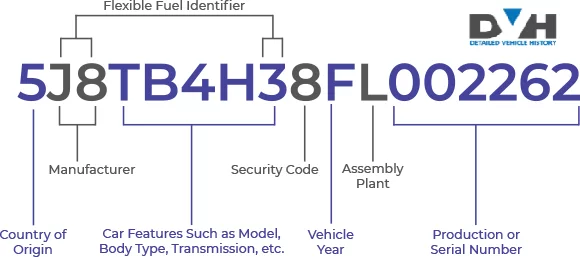Finding your car’s paint code can be exhausting if you don’t know where to look, especially if you want to ensure a perfect match for repairs or touch-ups. You might have noticed a scratch or chip on your vehicle and thought, “How do I fix this?” Without the right paint code, getting the exact colour can be tricky.
This article will guide you through the process of finding your paint code using your VIN (Vehicle Identification Number). By the end, you’ll know exactly where to look and how to get that perfect match for your car.
What is a VIN?
The Vehicle Identification Number (VIN) is a unique code assigned to every vehicle. It serves as a fingerprint for your car, containing vital information about its make, model, year of manufacture, and more. The VIN typically consists of 17 characters that include both letters and numbers. With this code, you are able to use vehicle check and track your vehicle’s history and specifications.
Each section of the VIN provides specific information:
- World Manufacturer Identifier (WMI): The first three characters identify the manufacturer.
- Vehicle Descriptor Section (VDS): Characters four to nine describe the vehicle’s model, body type, engine type, and safety features.
- Vehicle Identifier Section (VIS): The last eight characters provide details about the vehicle’s production number and year.
Knowing your VIN is crucial when searching for your car’s paint code. If you want to know more about your vehicle history by VIN, you can us our VIN decoder tool
Where is the VIN Located?
The Vehicle Identification Number (VIN) can usually be found in several spots on your car and also on vehicle documents. Common locations where you can find the VIN are:
- On the driver’s side dashboard, visible through the windshield
- Inside the driver’s side door frame or door pillar
- On your vehicle registration documents
- On your insurance card or policy paperwork
- Stamped on the engine block or under the hood
What does a car paint code look like?
A car paint code is a short set of letters and numbers that represents a vehicle’s exact paint colour. With the paint code, anyone can get a perfect paint colour for any vehicle during touch-ups or repairs.
Here’s what you need to know about car paint codes:
- Format: Usually 2–4 characters (e.g. LA7W, 040, 1AB, 3T3, etc.).
- Type: Can be letters, numbers, or a combination of both.
- Label terms: To easily find this code, you just need to look for “Paint,” “Color,” “PNT,” or “Ext. Color” on the label.
Examples:
- Toyota: 040 (Super White)
- Audi: LA7W (Ice Silver Metallic)
- Honda: NH-731P (Crystal Black Pearl)
If you’re buying a used car or trying to repair/repaint yours, a paint code ensures you get the exact car paint and avoid mismatches.
5 Ways to Find Paint Code by VIN
Finding your car’s paint code using the VIN is easier than you might think. These are some of the most effective ways to find yours:
Use an Online Paint Color Finder by VIN
One of the simplest ways to find your paint code by VIN is through a paint color check. With this tool, car buyers, sellers, and owners can enter their VINs and retrieve detailed information about their vehicles, including the paint codes and colors. This method saves time and effort, giving you instant access to the information you need.
The VIN check tool doesn’t just provide the paint or color of your vehicle but also lists additional details about your car’s specifications. They can help you understand more than just the paint code. You may also find out about all vehicle specifications, extras of my car, hidden history records, service history, outstanding finance, and more.
Check the Owner’s Manual
The next method to get your car’s paint code is the owner’s manual. Your owner’s manual often contains valuable information about your vehicle, including where to find the paint code. Look for sections that discuss maintenance or vehicle specifications. Many manufacturers include details about the paint code, and it should be easy to find.
If you don’t have a physical copy of your manual, many manufacturers provide digital versions online. Simply search for your vehicle’s make and model along with “owner’s manual,” and you should find a PDF version available for download. If you still can’t find it, you can try the next method.
Look for the Paint Code Label
All vehicles have a VIN/paint label or plate that displays the paint code. Common locations where you can find this label include:
- Driver’s side door jamb: Open the driver’s door and look at the edge or pillar. This is one of the most common places to find it.
- Under the bonnet: Some manufacturers place this label near the radiator or on the inner fender and a quick look should do the trick.
- Boot lid: Check inside the boot for any labels that might contain this information.
- Near the front windshield: Some cars have labels on the dashboard near where it meets the windshield.
The label usually includes a combination of letters and numbers that represent the specific colour used on your car. Be sure to check multiple locations if you’re having trouble finding it.
READ ALSO: How to Sell a Car Privately in the UK: Ultimate Guide
Contact the Manufacturer or Dealership
If you’re still having trouble finding your paint code, consider contacting your vehicle’s manufacturer or local dealership. They can use your VIN to look up detailed information about your car, including its paint code. This option is particularly useful if you own a rare or vintage model.
When contacting them, be prepared with all necessary details about your vehicle, including its make, model, year, and any specific features. This will help them assist you more efficiently.
Use a Paint Code Scanner
Another option is a paint code scanner. These devices read colour codes directly from your vehicle’s surface. They work by scanning existing paint and matching it to a database of known colours.
These scanners are often used by professional auto body shops but are becoming more accessible for DIY enthusiasts. If you’re serious about maintaining or restoring classic cars, investing in one could be worthwhile.
Use a Paint Code App
Several mobile apps can help you find your car’s paint code by simply entering your VIN or scanning a barcode. These apps often provide additional features, such as locating nearby suppliers who can mix touch-up paint based on your specific code.
Some popular apps include:
- PaintScratch: This app allows users to enter their VIN and get instant access to their car’s colour codes.
- Car Color Finder: With this app, users can search for their vehicle’s colour based on make and model or scan barcodes directly from their cars.
These apps make it easy to access vital information while on-the-go.
Can I Look Up a Car Paint Code by VIN Number?
Yes, you can look up a car paint code by VIN number with a VIN check tool. A VIN check tool decodes a VIN to show all vehicle specifications, features, and vehicle history records.
While it doesn’t show the paint code itself, a history check shows the original colour of a vehicle, as well as if the car’s paint has been changed in the past.
READ ALSO: How to Find Your VIN Number from a Registration Plate
Common Paint Codes Locations For Different Makes in the UK
Want even more specific locations? Check this list of popular vehicles and where you can find the paint code:
Ford
For Ford vehicles, you can find the paint code on the driver’s door frame, the lid of the boot, or under the bonnet. Ford paint codes may be alphanumeric or colour names like “Moondust Silver” or “Shadow Black.”
Vauxhall/Opel
For Vaxhaul or Opel, you can check the door frame or under the bonnet. These paint codes are often three-character alphanumeric codes like 4OR or 547 (sometimes you may find it near fuel cap or boot bay).
These cars also have their exact colour names that match the codes, like the “Switchblade Silver” or “Agean Blue.”
VW / Audi / SEAT / Škoda / Porsche
To find the paint code on a Volkswagen, SEAT, Skoda, or even a Porsche, you can check the boot area near the spare wheel or under the bonnet. Look for alphanumeric codes from 2-4 characters in length like 8530, 8T, 4K, or LA7W.
BMW / MINI
You can find a BMW or MINI paint code typically under the bonnet on strut towers or driver door jamb. Check for codes like 300 (Alpine White) or A52 (Space Grey).
Mercedes‑Benz
For Mercedes, the paint code will often be on the radiator support, bonnet underside, or driver’s door frame. Some examples are 359, 792, 650, Obsidian Schwarz, etc
Toyota / Nissan
For Toyota and Nissan vehicles, the paint code should be on the driver’s side door frame or pillar. Some examples are 1F7, QAB, KH3.
Why Knowing Your Paint Code Matters
Understanding why knowing your paint code is essential can help motivate you to find it quickly. Here are some reasons:
- Matching Repairs: If you’ve had an accident or just need minor touch-ups, using the correct paint ensures that repairs blend seamlessly with existing surfaces.
- Resale Value: When selling or trading in your vehicle, having accurate repair records—including paint codes—can enhance its value.
- Customization: If you’re considering customising or restoring a classic car, knowing the original paint code helps maintain authenticity.
- Preventing Mistakes: Using incorrect colours can lead to mismatched panels, which affects not only aesthetics but also resale value.
Conclusion
Finding your car’s paint code by VIN doesn’t have to be complicated. You can try any of the plenty options listed in this article and still find out the paint code and actual color of your vehicle. Knowing your paint code ensures that any repairs you would like to make blends properly with your vehicle’s original finish.
If you’re in the market for a used vehicle, remember that alongside the actual color of the vehicle, you need to be aware of it’s history and vehicle specifications. This helps to verify it’s reliability and determine the actual value of the vehicle.
So, take advantage of our car reg check or VIN check tools and access everything from vehicle engine size to insurance write-offs, ULEZ compliance checks, and more!
FAQS About What Is My Paint Code by VIN
Can you find paint code by VIN number?
You can find your vehicle’s exact color with the VIN number through a vehicle history report. Simply enter the VIN or reg number to see the actual colour of your vehicle and verify any color changes.
Can the VIN tell me the color?
Yes, the VIN can tell you the exact colour of your vehicle with a VIN check. A VIN check shows the exact colour and colour changes any vehicle may have gone through in the past.
How do I find the exact colour of my car?
You can find the exact colour of your car with a VIN lookup or a car reg check.



